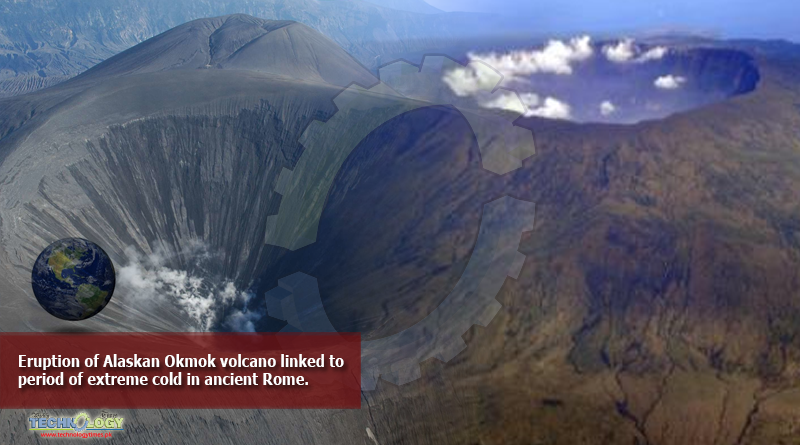Eruption of Alaskan Okmok volcano linked to period of extreme cold in ancient Rome.

For ages, the shadow of a volcano has hung over the fall of the Roman Republic. Ancient historians told of the Sun’s mysterious disappearance after Julius Caesar’s murder in 44 B.C.E., which was followed by bouts of cold and crop failures. Now, a team of scientists and historians has discovered that one of the largest known eruptions in history struck in 43 B.C.E.—potentially contributing to 2 years of weird weather and famine as the republic dissolved and the empire took shape.
The darkened sky after Caesar’s assassination on the Ides of March was likely caused by a known, small eruption at Mount Etna. But early the next year, in January or February, Alaska’s Okmok volcano in the Aleutian Islands blew its stack, forming a giant, 10-kilometer-wide crater rim. The volcano’s northern location meant that sunlight-blocking particles could rise into the low-lying Arctic stratosphere, where they would spread easily throughout the Northern Hemisphere, the researchers report in a new study, published today in the Proceedings of the National Academy of Sciences. “We can absolutely say this volcanic eruption generated extreme climate,” says Joseph McConnell, a glaciologist at the Desert Research Institute and the study’s lead author.
If the eruption did indeed contribute to famine and other disruptions, it could have helped the Roman Empire consolidate its control, McConnell says. “The end of the republic happened during these two extreme years of climate,” he says. “It’s a possible coincidence, but it doesn’t seem likely.”
Some scholars are skeptical and point out that the republic was on its way out well before the eruption. Caesar crossed the Rubicon in 49 B.C.E., precipitating the Roman civil war; 5 years later, he was named dictator for life. “The problems with the republic were political, deep in origin, fought out between members of the elite, not a popular revolution or a subsistence crisis,” says Guy Middleton, an archaeologist at Charles University. And, although the dating and identification of the eruption look undisputable, the evidence supporting the volcano’s climate impact is thin, especially for the Mediterranean, says Kevin Anchukaitis, a paleoclimatologist at the University of Arizona,. “From the little data we have, the local climate story might be a bit more complicated.”
Spikes in light-blocking sulfate particles recovered from deep ice cores in Greenland had previously indicated a major eruption occurred around this time, but its exact location and timing was a mystery. McConnell’s team examined one of these cores, from Greenland’s north, counting down in time through the core’s annual layers from a known Indonesian eruption in 1257 C.E. The team found a clear and heavy spike of sulfur at 43 B.C.E. Measurements of sulfur isotopes also made clear that the particles had been exposed to ultraviolet radiation in the stratosphere, where they could spread and linger for many months or years before returning to Earth.
In another ice core, the researchers found 35 shards of volcanic glass. They compared the composition of the glass with geochemical fingerprints of volcanoes known to be active at the time. Often, such matching is vague and inconclusive. But this time, only Okmok, a shield volcano that remains active today, could explain it. “The tiny glass particles in the ice are a clinching piece of evidence,” says Siwan Davies, a geographer at Swansea University who was not involved in the study.
The scientists then simulated the eruption in a climate model—one some scientists think exaggerates the cooling effect from eruptions—and found that the aerosols could have cooled southern Europe and northern Africa by up to 7°C. The team looked for corroboration about the climate in three tree ring archives that stretch this far back. Ones from Scandinavia and North America show clear cooling in 43 and 42 B.C.E. But the one from the Alps shows a cooling trend that began 10 years before the eruption, with 45 B.C.E. its coolest year, Anchukaitis says. “If we’re connecting Roman Republican history to climate and volcanoes, we need more of these records,” he says.
What does exist are historical documents. Letters from Cicero, the Roman statesman whose death in 42 B.C.E. is considered the symbolic end of the republic, mention cold weather around the time of the eruption. Other sources document famines in northern Italy by that April, and in northern Greece the next year. Plutarch, the famed Roman biographer, wrote that the men in Mark Antony’s army faced terrible famine in April of 43 B.C.E. and had to eat wild fruit, roots, and bark. Appian, a historian, said Rome was devastated by famine in 42 B.C.E.
Similar famines were seen in Egypt, and it’s tempting to speculate that they weakened Egypt, making it a perfect moment for Octavian, Caesar’s successor, to conquer it and solidify his hold on the nascent Empire, says Joseph Manning, a historian at Yale University. “The challenge is not to be overdramatic,” he says.
Because even with this potentially huge cooling event, Mediterranean society does not collapse, Manning says. This is not environmental determinism. “It’s more complex than collapse or resilience,” he says. Some people responded well, some poorly. The response is regional and subtle—and potentially, he adds, a perfect study for how humanity today will respond to its own changing climate.
Originally Publish at: https://www.sciencemag.org/
